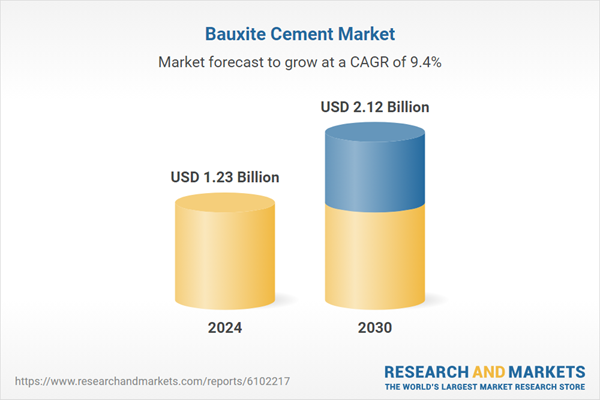Speak directly to the analyst to clarify any post sales queries you may have.
10% Free customizationThis report comes with 10% free customization, enabling you to add data that meets your specific business needs.
Key Market Drivers
Rising Demand for Refractory Applications in Steel and Metallurgy Industries
The global steel and metallurgy sectors are key drivers of bauxite cement demand due to their need for high-performance refractory materials. Bauxite cement, also referred to as calcium aluminate cement, provides strong thermal stability, chemical resistance, and mechanical durability, making it ideal for use in linings of furnaces, ladles, and kilns. Emerging economies such as India, China, and Brazil are expanding their infrastructure and industrial base, contributing to higher steel output and, consequently, increased consumption of refractory-grade bauxite cement.Additionally, the shift toward electric arc and induction furnaces, known for their efficiency and environmental benefits, has fueled demand for advanced refractory solutions where bauxite cement plays a vital role. The metallurgical industry’s reliance on high-alumina cement for smelters, converters, and other high-heat applications continues to rise, particularly as lightweight metals gain popularity in sectors such as automotive and aerospace.
Key Market Challenges
Limited Availability and Volatile Pricing of Raw Materials
The bauxite cement industry faces a significant constraint in the form of limited bauxite ore availability and fluctuating raw material prices. Bauxite mining is concentrated in a few countries, including Australia, Guinea, Brazil, and China, many of which have implemented export restrictions, environmental controls, or value-add mandates to protect domestic industries. These regulatory developments, along with geopolitical uncertainties and labor disruptions, can create unpredictable supply scenarios for cement manufacturers.Environmental restrictions in China and export bans in countries like Indonesia have led to tighter supply and greater cost volatility for calcined bauxite - an essential input in cement production. These factors increase production costs and pose challenges for manufacturers who may struggle to absorb or pass on the additional expenses, particularly when competing with lower-priced Portland cement alternatives.
Key Market Trends
Steady Growth Driven by Infrastructure Expansion and Refractory Demand
The market for bauxite cement is experiencing consistent growth due to its expanding role in both construction and refractory sectors. In infrastructure, the material is gaining favor for its fast-setting time, early strength, and resilience in corrosive or high-temperature environments. It is increasingly used in projects such as sewage treatment plants, tunnels, and specialized buildings.In the refractory industry, bauxite cement’s high alumina content makes it essential for applications subjected to thermal stress, including steel furnaces, ceramic kilns, and glass production. As developing regions increase investments in industrial capacity and developed nations modernize aging facilities, demand for durable and efficient refractory materials remains strong. This dual growth trajectory ensures a stable, upward trend for the bauxite cement market.
Key Market Players
- Calucem GmbH
- Kerneos SA (Imerys company)
- Cimsa Cimento Sanayi ve Ticaret A.S.
- Almatis GmbH
- RWC Group
- Royal White Cement Inc.
- Henan Zhengzhou Mining Machinery Co., Ltd.
- Orient Abrasives Limited
- Oyak Cement Group
- Gorka Cement (CRH Group)
Report Scope:
In this report, the Global Bauxite Cement Market has been segmented into the following categories, in addition to the industry trends which have also been detailed below:Bauxite Cement Market, By Grade:
- Metallurgical Grade
- Refractory Grade
Bauxite Cement Market, By Application:
- Alumina for Metallurgical Purposes
- Cement & Mortar
- Refractories
- Abrasives
- Others
Bauxite Cement Market, By End-Users:
- Construction
- Industrial Kiln
- Sewage Treatment
- Others
Bauxite Cement Market, By Region:
- North America
- United States
- Canada
- Mexico
- Europe
- France
- United Kingdom
- Italy
- Germany
- Spain
- Asia-Pacific
- China
- India
- Japan
- Australia
- South Korea
- South America
- Brazil
- Argentina
- Colombia
- Middle East & Africa
- South Africa
- Saudi Arabia
- UAE
- Kuwait
- Turkey
Competitive Landscape
Company Profiles: Detailed analysis of the major companies present in the Global Bauxite Cement Market.Available Customizations:
With the given market data, the publisher offers customizations according to a company's specific needs. The following customization options are available for the report.Company Information
- Detailed analysis and profiling of additional Market players (up to five).
This product will be delivered within 1-3 business days.
Table of Contents
Companies Mentioned
- Calucem GmbH
- Kerneos SA (Imerys company)
- Cimsa Cimento Sanayi ve Ticaret A.S.
- Almatis GmbH
- RWC Group
- Royal White Cement Inc.
- Henan Zhengzhou Mining Machinery Co., Ltd.
- Orient Abrasives Limited
- Oyak Cement Group
- Gorka Cement (CRH Group)
Table Information
| Report Attribute | Details |
|---|---|
| No. of Pages | 180 |
| Published | June 2025 |
| Forecast Period | 2024 - 2030 |
| Estimated Market Value ( USD | $ 1.23 Billion |
| Forecasted Market Value ( USD | $ 2.12 Billion |
| Compound Annual Growth Rate | 9.3% |
| Regions Covered | Global |
| No. of Companies Mentioned | 10 |









